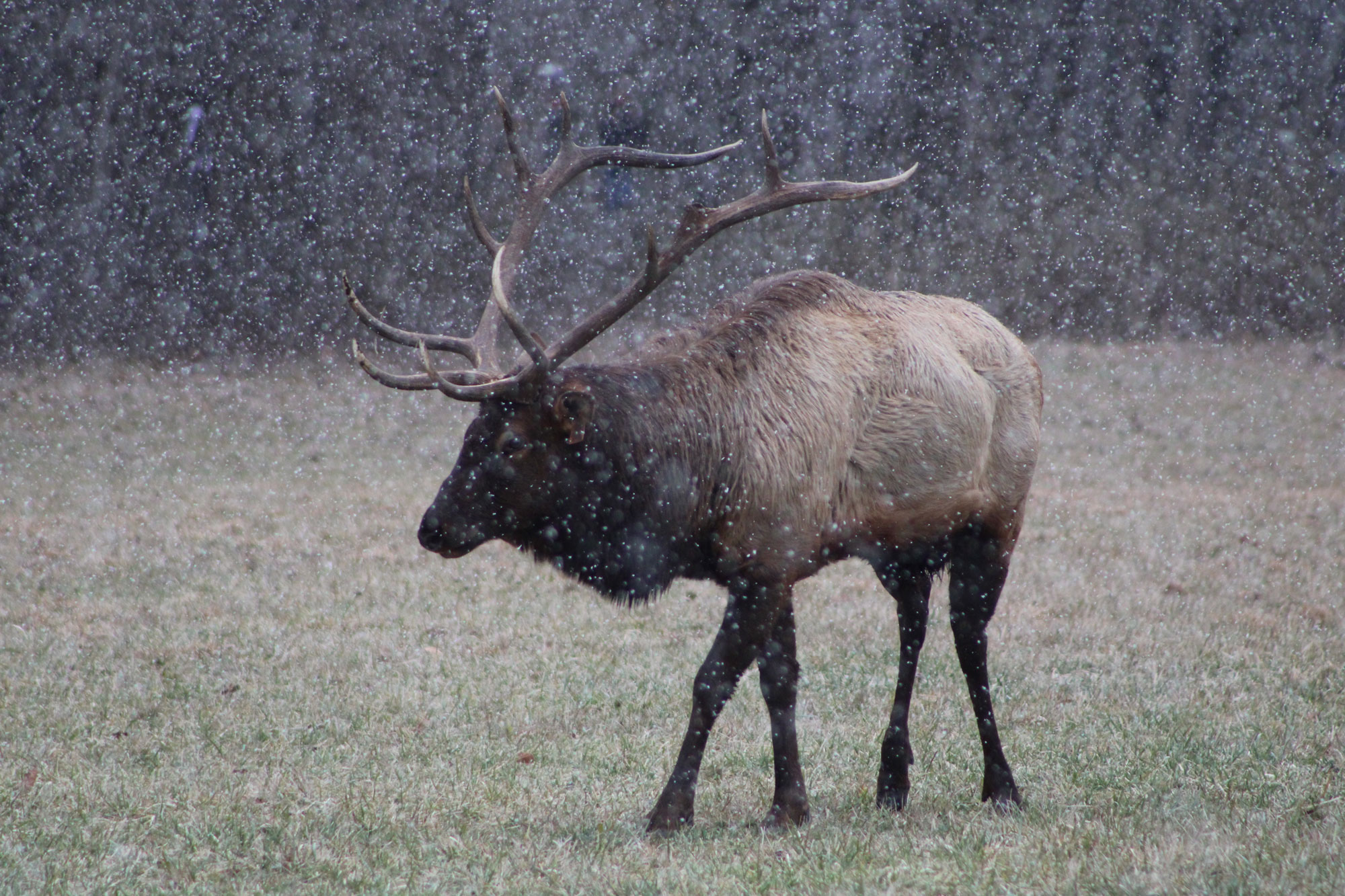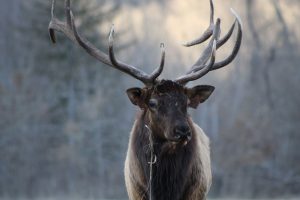
When I first started studying the bull elk of Oconaluftee last fall, I quickly learned that each male is an individual. They each have their own quirks that make them easily recognizable. One of the first males I began to study was a bull who goes by the name of “B” within the park service.

At nearly 14 years old, Bull B is one of the oldest bulls in the Smokies. In his prime, he topped off at over 1,000 pounds, though he was a troublemaker in his youth. One year, after picking too many fights with cars, park biologists sawed off his antlers, a painless method of lowering his testosterone and reducing his aggression. This intervention must have made an impact, as I have never seen B show such hostility towards vehicles or tourists since.
B’s impressive size has allowed him to have control over the Oconaluftee herd for years. He has only become more experienced with age, so much so that younger bulls are hesitant to pick a fight with him. Even the older males avoid Bull B if they can help it, and it’s easy to see why. His antlers are now massive, curling backwards and perfectly framing his figure. One recognizable feature is the second tine (or “point”) on his left antler, which is significantly longer than its sister tine on the opposite antler. Of the few sparring matches I’ve seen B participate in, his main weapon is his sheer strength and mass. There are few bulls in Oconaluftee that truly compare to B in size, and that alone is an advantage.
My experience with B began last year when I took it upon myself to study individual bulls during the rut. He was one of the first I saw regularly, and one who immediately made an impression. He was huge, yes, but it was his demeanor that intrigued me. Based on the research I had done beforehand, I expected a bull of his size to push his weight around, but B was different. That’s not to say that younger males walked all over him, or that he didn’t take sparring seriously, but he was far more gentle with his harem than I had expected. He was particularly benign with calves. I observed him allowing the little ones to follow him, watching his every move with awed curiosity. Yearling males were allowed to stay in his harem as long as they didn’t get too comfortable with one of his cows. He would let these bulls lock antlers with him, and though he could have easily put them in their place, he would instead humor them for a while before proving that he was, in fact, the leader of the herd. It’s this sort of patience and amiable attitude that makes Bull B one of the most memorable and charming bulls in the Smokies.
Close Encounters
Whenever you go out into elk territory, you always run the risk of a close encounter. Many believe that there’s no way an elk could sneak up on you. How could a beast so massive remain quiet enough to elude your detection until the last moment? But you would be surprised at how many times I haven’t seen or heard an elk until I was right up on it. While I’ve gone out of my way to ensure I’m never knowingly within fifty yards of any elk in the Smokies in keeping with park rules, I’ve not always been able to evade their unpredictable behavior.

One story in particular comes to mind. It was a chilly November evening, and the herd had been hiding from me all day. Finally, I spotted them from the road—they were in the horse pastures near the Smokemont riding stables, an area which they seem to frequent during certain times of the year. Luckily for me, there was a gravel trail that snaked past the fields, and it was far enough from the herd to ensure that my presence wouldn’t disturb them.
As I began walking the path, I noticed that no bull was in sight. This struck me as odd, since a harem of this size would certainly have a dominant male at the helm. I didn’t dwell on it too much, assuming that he was either out of sight or resting in the woods nearby. Bulls will sometimes lay in the forest and watch their herd from afar, and this was a behavior that was fairly common with the Oconaluftee males.
As I neared a large holly bush, I heard a snort. I abruptly stopped in my tracks, turning just in time to watch a bull come out from behind the foliage about ten feet from me. His gaze drifted in my direction, and his ears perked up as he regarded my frozen figure.
My first thought was of how strong their musk was up close. It was probably not the reaction that I should have had in that scenario, but it was quickly followed by a growing sense of unease. I had never been so close to a bull of his size, and I knew that their behavior could be unpredictable. If he wanted to, he could stomp me into a pulp in mere seconds before I even had the chance to run.

But this bull, whom I later realized was TN1, seemingly had no intention of doing so. I remember him lazily chewing cud, waiting for me to make my move. After a few moments, I began to back up, my eyes never leaving his. He huffed but didn’t come towards me. Once I had put a good 20 or 30 feet between us, he continued on his way, effortlessly leaping the nearby fence and rejoining his herd.
I consider myself lucky to have run into TN1 that day. Had it been any other male, I might have had a much different story to tell.
That said, elk in general are not overtly aggressive. In my experience, they would rather have nothing to do with people. Even so, the herd in the Smokies is more willing to graze near humans, giving some the impression that they are tame. This couldn’t be farther from the truth—our elk are wild animals, able to change their demeanor on a dime and capable of running much faster than you or me (40 miles an hour in mere seconds).
It is vital to always be on alert when in elk territory, since you never know when you’ll stumble upon a rutting bull or defensive cow. In the national park, it is unlawful to willingly approach an elk within 50 yards of the animal. This is important for us to remember, as it not only keeps us safe, but it also ensures that our elk will continue to remain wild.
Subscribe to get the latest posts sent to your email.
The Great Smokies Welcome Center is located on U.S. 321 in Townsend, TN, 2 miles from the west entrance to Great Smoky Mountains National Park. Visitors can get information about things to see and do in and around the national park and shop from a wide selection of books, gifts, and other Smokies merchandise. Daily, weekly, and annual parking tags for the national park are also available.